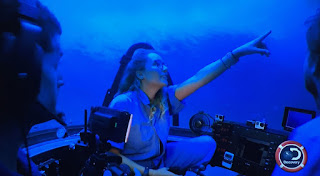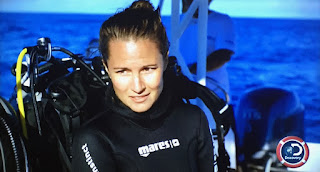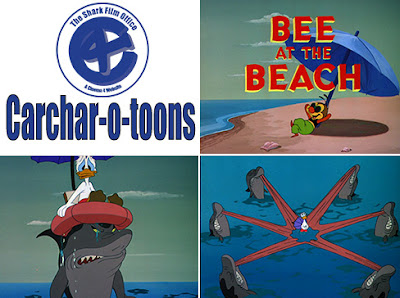Shark Week 2017, Pt. 3: Days 4 and 5
OK, I didn’t get to watch most of Shark Week last week on television. Because it is easier to take notes right on my computer, I chose to watch the bulk of Shark Week on Discovery Channel’s online site. But where it made one part of the project easier to do, I had to deal with the fact that I couldn’t easily skip the commercials like on the DVR had I watched everything in the living room or bedroom. And so, stuck by choice with seeing each episode online, I was forced to sit through the requisite amount of commercial breaks.
This might have been fine, but it also meant that I was forced into a couple hundred viewings of the trailer for The Hitman’s Bodyguard. This gave me great exposure to a film of which I was not even aware of in the least before Shark Week came along. To say that I have now been driven to madness to the degree that there is not a chance that I will see the film when it comes out in mid-August. Even with Sam Jackson, Ryan Reynolds and Gary Oldman, there is little hope for this film to get even rental money out of me, at least until a decent amount of downtime has occurred for me to lessen my now-negative attitude towards it and every hackneyed line in the trailer. They should have mixed it up with a trio of different trailers or even more. Instead, it was pounded through my eyes and into my head over and over, and now… their most likely audience member has been turned away. Sometimes, advertising too much can really work against your product…
#10 – The Lost Cage (premiered Wednesday, July 26, 2017)
 This episode has perhaps the oddest premise of any thus far this year. Interesting and different, yes, and a rather enjoyable effort, but definitely the oddest.
This episode has perhaps the oddest premise of any thus far this year. Interesting and different, yes, and a rather enjoyable effort, but definitely the oddest.Fish aggregation device. FAD. You have to know what that is before you can really get anything out of The Lost Cage. Usually they are buoys, balls or some other object, sometimes even rafts built from debris, that then gets rigged to the bottom of the ocean, and allowed to gather barnacles, corals, and other marine life to it to create mini eco-systems. The FAD floats in one area atop the surface and draws schools of fish to it. The fishing industry use these to attract schools of tuna or other preferred species to make it easier to locate and net the fish. Since fish are relative suckers for hanging around anything floating in the water, it makes the game easier for fishermen.
In The Lost Cage, a team of scientists take to see in a very simple raft design with barely any creature comforts – that they name Man O’ War – and float freely on the currents in the Gulf of Mexico for seven days and hundreds of miles. Chained to their raft and lying many meters below the surface from them is a shark cage, which before their trip is left to do what is called “biofouling,” the gather of the aforementioned marine life which will create that vital miniature eco-system so that the cage can start to attract bigger and bigger marine life to it. The cage barely starts to get covered in gunk before fish start to show up, and even dolphins come by to check it. The point of this free-floating exercise is to see if the FAD begins to attract sharks to it as well to gather evidence that sharks may possibly become bycatch when fishermen go to their own FADs to gather their fish.
When I called it “the oddest” premise this year, this was not to disparage the experiment. It’s just that it is a far different experiment than we usually see on Shark Week, which mainly consists of shark tagging and diving (cage or otherwise) and other activities built around those two. Last year, the title of oddest special had to be the one where Dr. Craig O’Connell was testing the use of magnets on sharks. (There will be more about shark magnetism in the next review, so stay tuned...) So it doesn’t necessarily have to be a concept that is all that weird for me to call something the oddest during Shark Week; it just has to be further from the norm than usual.
And it’s not like the scientists in The Lost Cage don’t tag sharks or go both cage and free diving with them. They get in the water and tussle with a huge mako, eventually tagging it, and they meet all sorts of creatures along their journey. But the idea that they are pretty much at the mercy of the current and have not necessarily made the journey particularly comfortable for themselves is pretty unique to the genre. It’s not Man vs. Wild discomfort (and c’mon, that’s a big put-on anyway); they have electronic equipment and a kitchen and food. They don’t live like savages, but the living quarters are the fairly small raft are pretty spare and mostly open to the elements. (Also, there is obviously a film crew traveling alongside them, so if anything major happened, they would have someone there to help.)
Makos, especially one that they identify, tag and name Scar, play a constant role throughout the show, and it will ultimately turn out that Scar has been tracking them since they first meet him near the beginning. Along the way, they take a neat stop by an abandoned oil rig, which themselves are usually to be found covered entirely by sea life below the surface, often creating lush paradises almost like vertical coral reefs teeming with life. That is the case here and it is a pretty monumental sight. (There was a special last year that spent a good amount of time working around old oil rigs to see how the areas were reacting to their presence.) Along with makos, we meet silky sharks and spinner sharks and a number of different fish species.
At a stop in the Flower Garden Banks National Marine Sanctuary, a large tiger shark swings into view around the divers, as well as a mix of sandbar sharks, and finally a tremendous manta ray. The divers first saw a solo hammerhead early in the show but now at the Flower Garden Banks, the sighting of a single hammerhead leads them to look about and realize they are surrounded by a massive gathering of hammers. In the dark of night not long after, flying fish are seen on the surface of the water, so they dive back into the blackened waters to get a closer look at the winged wonders. While in the water, first a scalloped hammerhead arrives and then a rather aggressive spinner shark smacks right into the camera. A short while later, with the divers in the water again, the return of Scar is greeted with elation, but from the evidence seen here, sharks may be as attracted to FADs as other fish are. It is likely that even more sharks are being taken as bycatch by fishermen than previously thought.
OK, just one more thing… I don’t know if the same person does the opening title graphics for all of the episodes, but if it is so, I wonder if that person has some sort of aversion to articles such as “the” in their titles. In the graphic for what is usually described as Return to the Isle of Jaws on promotional materials and on TV schedules (even on the Discovery Channel website in multiple places), the title on the show appears as Return to Isle of Jaws, as if the old Johnny Weissmuller version of Tarzan was saying it. (Ooh, now he could probably out-swim a great white...) it is cut down to just For this episode, The Lost Cage appears as Lost Cage on the title card. So, what’s the deal, Discovery Channel graphics person/people? Do you just hate the word “the”? Or is there just bad quality control behind the scenes? Just wondering… TC4P Rating: 7/9
#11 – Devil Sharks (premiered Wednesday, July 26, 2017)
 Once more, we have a title that could likely end up as a Sharknado Week original film on Syfy in the future. I don’t know what form it could take, but I envision a death metal band desperate to make their mark plays a free concert just off the beach on a floating platform, and while the audience floats around on boats, kayaks, surfboards, and inner tubes listening to the music, the local sharks mutate into demons and attack the audience.
Once more, we have a title that could likely end up as a Sharknado Week original film on Syfy in the future. I don’t know what form it could take, but I envision a death metal band desperate to make their mark plays a free concert just off the beach on a floating platform, and while the audience floats around on boats, kayaks, surfboards, and inner tubes listening to the music, the local sharks mutate into demons and attack the audience.That’s a far cry from what happens in the Shark Week version of Devil Sharks, where the title is simply to imply the connection between the lava of volcanoes and the underworld of legend. That’s right, sharks and volcanoes. Naturally, my mind goes back to Joe vs. the Volcano, a particular favorite of mine that, as luck would have it, is also a shark movie. (Had you forgotten the scene where Tom Hanks is fishing off the yacht and catches a small hammerhead shark, which then makes a snarly face at Hanks and scares the bejeezus out of him? If you had, then you are no fan...)
Dr. Mike Heithaus of Florida International University has evidence that sharks are quite often found around islands with not just a lot of volcanic activity, but even places where the volcanoes are either dormant or even dead. He wonders if sharks use the magnetic properties of volcanoes to help them circumnavigate the globe, and sets out in Devil Sharks to the Caribbean towards Saba Island, which has a dormant volcano as its main feature, to gather even more evidence. First his team captures and tags a tiger shark near the island and then releases her. (They also tag other sharks off-camera as part of the study.) Over the span of several months, Heithaus tracks the movements of the tagged sharks and realize that they may be using underwater volcanic ridges to travel from place to place. The question is… why?
Scientists theorize that sharks, being sensitive to magnetism, probably pick up magnetic signals which are locked inside lava, and use those signals to navigate through the ocean. Heithaus thinks this may explain why sharks are able to cross an entire ocean to return to the exact same spot they frequented before.
The big action in this episode takes place around Hawaii, where Heithaus and his team want to figure out why sharks continue to hang around volcanic islands once they have travelled to one. Mike and marine scientist Kirk Gastrich dive in open water and find themselves surrounded quickly by Galapagos and sandbar sharks. The narrator says ominously, “No chum needed here. Dave and Kirk… are the bait.” But, c’mon… it’s just something to say before a convenient commercial break before we return to the show and find out most of the sharks really don’t care about these guys at all. Sure, one shark seems to start to stalk Kirk so they call off the dive, but I am going to say this was more in service to telling a thrilling story.
Onshore at Hawaii, vulcanologist Jess Phoenix joins them a short ways from Kīlauea to show Heithaus how lava forms into new land as it hits the ocean and cools. My favorite part of the show occurs just after they show us the creation of pillow lava, and how tunnels can be created inside the hardened lava. Sharks lurk sometimes in these tunnels. They dive at Kona Coast to check out examples of this. Checking out the coral reef, we encounter a moray eel and a whitetip reef shark. On the surface, we see a tiger shark attempting to attack a seabird. We see tiger sharks stalking whale calves and also feeding on a dead whale. Mike and his wife Linda dive down to a lava tube mouth, careful to watch out for sharks in the darkness. They find a whitetip reef shark hiding beneath the tube, probably hiding from tiger sharks. It panics and rushes past Mike and the cameraman, trying to escape. They find more sharks hiding in crevices, possibly sleeping though their eyes are open.
The team heads to Rangiroa in the South Pacific to investigate shark behavior around a dead volcano to find out why sharks would be interested in a volcano at the end of its life. They find gray and blacktip reef sharks aplenty in the water. They notice that many of the blacktip females have love bites on their sides, leading them to believe the sharks are using this area as a mating and pupping ground. Later, when they go to the island, they catch baby blacktip sharks by hand while standing on the beach to gather DNA samples and take blood.
To close out the episode, they free-dive (to keep the scuba bubbles from frightening the sharks) in order to collect flesh samples using a speargun, while also using a bait basket to attract sharks. At first, they are dealing only with silvertips, and at first the sharks surround the divers. But the silvertips clear out when a tiger shark arrives suddenly. The diver stops the shark’s progress with the tip of his speargun, and then uses to collect the vital flesh sample from the tiger, sending the big shark scurrying away. All in all, a solid episode with some fine underwater photography and a couple of exciting scenes. The volcano angle proves far more worthy of interest than I first thought, making it two years in a row in which a special featuring magnetism and sharks has done that to me. – TC4P Rating: 7/9
#12 – Shark Exile (premiered Thursday, July 27, 2017)
 And now here comes another episode that I found far more compelling than I first thought when I head what the subject matter entailed. Shark Exile features diver and former shark attack victim Paul de Gelder, who is now a major shark advocate, as he attempts to help save sharks along the coast of his native Australia by learning a recent technique developed by a shark researcher in Recife, Brazil regarding the “exiling” of sharks from the vicinity of the public beaches in that city.
And now here comes another episode that I found far more compelling than I first thought when I head what the subject matter entailed. Shark Exile features diver and former shark attack victim Paul de Gelder, who is now a major shark advocate, as he attempts to help save sharks along the coast of his native Australia by learning a recent technique developed by a shark researcher in Recife, Brazil regarding the “exiling” of sharks from the vicinity of the public beaches in that city. De Gelder longs to aid Australia in no longer relying on the old methods of shark-netting and baited lines to keep sharks from beaches, which results in the needless death of countless sharks and other marine species every year. Having heard of the success of this Brazilian method – in which the exiled sharks seemingly do not return back to Recife – De Gelder starts out in his home surf with his team and captures, tags, and releases a gorgeous-looking tiger shark. The reason is to establish his own method to understand the pros and cons of transporting the shark, which proves to be a problem since they hooked a much larger shark than they expected. Instead of pulling the shark onboard their boat, they keep the shark wrapped in a tarp alongside the boat so the water continues to flow through its gills. There is a complication when they release the tiger because one of its gills gets caught on the protective tarp, but De Gelder jumps in to get the shark free and it swims away unharmed.
De Gelder longs to aid Australia in no longer relying on the old methods of shark-netting and baited lines to keep sharks from beaches, which results in the needless death of countless sharks and other marine species every year. Having heard of the success of this Brazilian method – in which the exiled sharks seemingly do not return back to Recife – De Gelder starts out in his home surf with his team and captures, tags, and releases a gorgeous-looking tiger shark. The reason is to establish his own method to understand the pros and cons of transporting the shark, which proves to be a problem since they hooked a much larger shark than they expected. Instead of pulling the shark onboard their boat, they keep the shark wrapped in a tarp alongside the boat so the water continues to flow through its gills. There is a complication when they release the tiger because one of its gills gets caught on the protective tarp, but De Gelder jumps in to get the shark free and it swims away unharmed. |
| "What the hell did I ever do to anybody? I'm a nurse shark!" |
 |
| "D'oh!" |
I really found the subject fascinating, and especially liked seeing the warts and all approach of how they were learning to handle these sharks in both locations on different sides of the world. That both places had similar results means there might be something to this method, but there are unanswered questions. While they mention the currents off Brazil are instrumental in moving the sharks away, I have to wonder if maybe there is a human factor at play here. If I were a shark who is just swimming about doing my shark thing, and then a bunch of people hook me, pull me into a boat, cut a hole in my back and shove something into it, and then drive me hours atop the water, and then let me go, I might want to shy away from the area where I was. I know I would as a human, so could a shark react the same way? Is picking the sharks up and quite literally moving them elsewhere the key to safer beaches? Hey, if it means less sharks get killed, I am all for it. Definitely a sequel somewhere in this special. – TC4P Rating: 8/9
#13 – Shark Storm (premiered Thursday, July 27, 2017)
 When I saw the title Shark Storm, I thought it had finally happened. At some point, someone on Shark Week would have to discuss sharks in conjunction with storms, given how much the idea of a sharknado is now on the minds of every idiot in America. And I thought Shark Storm was that moment…
When I saw the title Shark Storm, I thought it had finally happened. At some point, someone on Shark Week would have to discuss sharks in conjunction with storms, given how much the idea of a sharknado is now on the minds of every idiot in America. And I thought Shark Storm was that moment…And I was wrong. The show could just as likely be called Shark Swarm, but there was already a new special with that title appearing last week on the rival SharkFest on Nat Geo Wild. But “storm” is just a fine a descriptor as “swarm” when one is talking about massive aggregations of sharks, sometimes even multiple species, that can be found at various spots all around the world.
 Now, last year, during my writeup for a Shark Week 2016 special titled The Killing Games, I went more than a little goggle-eyed over a comely shark scientist named Ornella Celine Weideli. You see, I watch these shows for the sharks, and have little thought that I am going to cross paths visually with someone like Dr. Weideli. And, no matter how much I have tried to evolve my behavior and renounce all my damnable born instincts, I am also still just enough of a Neanderthalic male to get all territorial over her and want to mark all the furniture in the cave. You see, the girl done broked my widdle bwain...
Now, last year, during my writeup for a Shark Week 2016 special titled The Killing Games, I went more than a little goggle-eyed over a comely shark scientist named Ornella Celine Weideli. You see, I watch these shows for the sharks, and have little thought that I am going to cross paths visually with someone like Dr. Weideli. And, no matter how much I have tried to evolve my behavior and renounce all my damnable born instincts, I am also still just enough of a Neanderthalic male to get all territorial over her and want to mark all the furniture in the cave. You see, the girl done broked my widdle bwain...It’s a year later, and Ornella (cute little nose ring and all) is back in Shark Storm, teaming up with Dr. Tristan Guttridge as they travel from location to location to try and surmise exactly why sharks gather like this and what might be behind that behavior. I mean, she’s still awful purty and all, and I did shout out a little “yes!” (with a fist pump to boot) when I saw she was in this episode, but other than that, I was content to let her be the professional scientist that she is and simply watch her conduct her experiments without any further brutish behavior on my part.
 After all, I am a man who is concerned first with saving sharks in our oceans. I don’t have time to think about how much I wish it was me in that cramped submersible with Ornella as we dive down under the Caribbean near Cocos Island off Costa Rica to encounter hammerhead sharks all swimming in what seems to be mutual peace with one another. Were I there, we would have science to do, and would have to remain alert to the dangers when diving beneath the sea. How could I possibly think of anything else? Besides, I am a married man in a deeply committed relationship. Hey, Dr. Jones… no time for love...
After all, I am a man who is concerned first with saving sharks in our oceans. I don’t have time to think about how much I wish it was me in that cramped submersible with Ornella as we dive down under the Caribbean near Cocos Island off Costa Rica to encounter hammerhead sharks all swimming in what seems to be mutual peace with one another. Were I there, we would have science to do, and would have to remain alert to the dangers when diving beneath the sea. How could I possibly think of anything else? Besides, I am a married man in a deeply committed relationship. Hey, Dr. Jones… no time for love... So, let’s leave it to Ornella and Tristan to carry out the rest of the mission as it is meant to be on Shark Storm. They decide that the submersible doesn’t get them close enough so they scuba dive in a spot to wait for the hammerheads to arrive. The sharks indeed arrive and move about in a tightly constructed mass featuring at least two hundred individuals, and exhibiting what could only be described as communicative behavior of some form.
So, let’s leave it to Ornella and Tristan to carry out the rest of the mission as it is meant to be on Shark Storm. They decide that the submersible doesn’t get them close enough so they scuba dive in a spot to wait for the hammerheads to arrive. The sharks indeed arrive and move about in a tightly constructed mass featuring at least two hundred individuals, and exhibiting what could only be described as communicative behavior of some form.Back at the lab in the Bahamas, they observe a group of smaller lemon sharks from towers above the mangroves where the sharks spend their early years. They see many of the same body language and social cues with the lemons that they saw with the hammerheads. Guttridge theorizes that since the sharks could easily avoid each other there but prefer instead to gather together, that they must get some satisfaction at some level out of being social. They decide to visit other shark species to check out more behavior, and head off the coast of Mexico to join a school of hundreds of whale sharks that only gathers once annually. While there they drag a net behind the boat and pull in a collection of what turns out to be tuna eggs. The Mexican whale shark expert calls it “Mexican caviar” as a joke, but then proceeds to stick his finger into the batch of eggs and taste it, which Ornella and Tristan also try as well.
 When they snorkel with the massive whale sharks (since the Mexican government doesn’t allow scuba gear around these sharks for fear of frightening them away), Ornella and Tristan notice that the same behavior they saw with the smaller species is not at play here. From as much as they can tell, the sharks are merely content to cruise along with each other, and display no noticeable body language between each other. Since the whale sharks are too big with which to experiment, they decide to head back to Bimini and perform some tests in a pen with lemon sharks, which they describe as sort of the “lab rat” of shark experiments. They set up the pen with targets and covers to try and train a lemon shark to hit the correct target to get fed. It takes about two weeks, but the shark finally gets the idea and starts to hit the right target and gets food for his efforts. They then attempt to see if an inexperienced shark can learn the same trick from observing the now learned shark. The second shark learns the behavior in less than two days, and then both sharks start competing over who gets to hit the target first.
When they snorkel with the massive whale sharks (since the Mexican government doesn’t allow scuba gear around these sharks for fear of frightening them away), Ornella and Tristan notice that the same behavior they saw with the smaller species is not at play here. From as much as they can tell, the sharks are merely content to cruise along with each other, and display no noticeable body language between each other. Since the whale sharks are too big with which to experiment, they decide to head back to Bimini and perform some tests in a pen with lemon sharks, which they describe as sort of the “lab rat” of shark experiments. They set up the pen with targets and covers to try and train a lemon shark to hit the correct target to get fed. It takes about two weeks, but the shark finally gets the idea and starts to hit the right target and gets food for his efforts. They then attempt to see if an inexperienced shark can learn the same trick from observing the now learned shark. The second shark learns the behavior in less than two days, and then both sharks start competing over who gets to hit the target first. For their next test of shark intelligence, they move up to whitetip reef sharks, with whom they dive in a return to Cocos Islands. They already know that whitetips are social, swimming together in groups of hundreds of sharks, but they want to use acoustic receivers around the area and then tag a specific number of sharks and then see if the same sharks continue to group together or if the school is more chaotic in nature. When they dive, they find small groups of whitetips resting on the bottom of the ocean calmly. Tristan goes about tagging sharks while Ornella records the tag information, and then switch off roles. Tristan tags a larger male with a different type of receiver to see if any of the tagged sharks are “preferred partners” with that shark.
 The pair then prepare for a night dive with the same species of sharks. The difference will be that sharks are usually far more aggressive at night, preferring to feed in the darkness. They aim is to see if the shark collaborate together in pack hunting or whether it will be a frenzied free-for-all. They notice sharks scaring fish out of crevices in the coral to push them out to the pack. The proof is pretty clear that they hunt as a pack. Ornella and Tristan find two sharks that were tagged together who are still hanging out more than 60 hours later, working together to get a meal.
The pair then prepare for a night dive with the same species of sharks. The difference will be that sharks are usually far more aggressive at night, preferring to feed in the darkness. They aim is to see if the shark collaborate together in pack hunting or whether it will be a frenzied free-for-all. They notice sharks scaring fish out of crevices in the coral to push them out to the pack. The proof is pretty clear that they hunt as a pack. Ornella and Tristan find two sharks that were tagged together who are still hanging out more than 60 hours later, working together to get a meal. Is Shark Storm a good episode? Of course… We get some neat experiments testing both the intelligence of sharks and their social interactivity. Nothing new, but the show is informative enough. Is the scenery far nicer than I expected going into it? Well, I would be a cad to say yes or no, but I will say that Shark Storm is very well-photographed and the choices of locale are diverse and interesting. Plus, I am prone to liking episodes where a submersible is employed, so it has that going for it as well. As for Dr Weideli, it is nice to see her on another episode. If she is on every episode next year, it will be even nicer, but I have to remember that I am tuning in for the sharks. – TC4P Rating: 7/9
Well, that's it for Part 3. We've knocked down the first thirteen episodes (and a preview) of Shark Week 2017, but there are four more shows to go. (One of them is just a highlight episode, so it will only take a paragraph or so.) I will have the fourth and final part up sometime this weekend. See you then!
Same shark-time, same shark-channel,
RTJ




Comments